Page 162 of 180
8-52
8
9
10
11
12
13
14
1. Do not touch the glass part of the bulb.7. Connect the headlight coupler.
8. Install the bulb cover and the cover at the rear of the headlight. NOTICE: Make
sure the headlight bulb cover is se-
curely fitted over the bulb holder and
seated properly.
9. Adjust the headlight beam if necessary.
EVU00990Headlight beam adjustmentNOTICEIt is advisable to have a Yamaha dealer
make this adjustment.To raise the beam, turn the headlight beam
adjusting screw in direction a.
To lower the beam, turn the headlight beam
adjusting screw in direction b.1. Headlight beam adjusting screw
1
a
b
1XP7B_EE.book Page 52 Tuesday, February 4, 2014 3:40 PM
Page 163 of 180
8-53
1
2
3
4
5
6
78
9
10
11
12
13
14
EVU01000Tail/brake light bulb replacementIf a tail/brake light bulb burns out, replace it as
follows:1. Remove panel A (if replacing the left tail/ brake light bulb) or panel B (if replacing
the right tail/brake light bulb) by removing
the quick fastener screws, nuts and bolts.1. Panel A 1. Panel B
1. Quick fastener screw (
× 8) 2. Bolt and nut ( × 2)
3. Panel A
1
1
1
3
2 1
1XP7B_EE.book Page 53 Tuesday, February 4, 2014 3:40 PM
Page 164 of 180
8-54
8
9
10
11
12
13
14
2. Remove the tail/brake light bulb holder (together with the bulb) by turning it coun-
terclockwise.1. Tail/brake light bulb holder3. Push the burnt-out bulb in and turn itcounterclockwise to remove it from the
bulb holder.
4. Push a new bulb in and turn it clockwise to install in the bulb holder.
5. Install the bulb holder (together with the bulb) by turning it clockwise.
6. Install the panel. 7. Install the quick fastener screws, bolts
and nuts and then tighten the nuts to the
specified torque.
1
Tightening torque:Panel nut: 7 Nm (0.7 m·kgf, 5.1 ft·lbf)
1XP7B_EE.book Page 54 Tuesday, February 4, 2014 3:40 PM
Page 165 of 180

8-55
1
2
3
4
5
6
78
9
10
11
12
13
14
EVU01010TroubleshootingAlthough Yamaha vehicles receive an inspec-
tion before shipment from the factory, trouble
may occur during operation. Any problem in
the fuel, compression, or ignition systems can
cause poor starting and loss of power. The
troubleshooting chart describes a quick, easy
procedure for making checks. If your vehicle
requires any repair, take it to a Yamaha deal-
er.
The skilled technicians at a Yamaha dealer-
ship have the tools, experience, and know-
how to properly service your vehicle. Use only
genuine Yamaha parts on your vehicle. Imita-
tion parts may look like Yamaha parts, but
they are often inferior. Consequently, they
have a shorter service life and can lead to ex-
pensive repair bills.
WARNING
When checking the fuel system, do not
smoke and make sure there are no open
flames or sparks in the area, including pi-
lot lights from water heaters or furnaces.
Gasoline or gasoline vapors can ignite or
explode, causing severe injury or property
damage.
1XP7B_EE.book Page 55 Tuesday, February 4, 2014 3:40 PM
Page 170 of 180

9-3
9
10
11
12
13
14
2. Remove the spark plug, pour about one tablespoon of SAE 10W-40 or 20W-50
motor oil in the spark plug hole and install
the spark plug. Ground the spark plug
wire and turn the engine over several
times to coat the cylinder wall with oil.
3. Lubricate all control cables.
4. Block up the frame to raise all wheels off the ground.
5. Tie a plastic bag over the exhaust pipe outlet to prevent moisture from entering.
6. If storing in a humid or salt-air atmo-
sphere, coat all exposed metal surfaces
with a light film of oil. Do not apply oil to
any rubber parts or the seat covers. 7. Remove the battery and charge it. Store
it in a dry place and recharge it once a
month. Do not store the battery in an ex-
cessively warm or cold place [less than
0 °C (30 °F) or more than 30 °C (90 °F)].
Use of fuel stabilizer and conditioner elimi-
nates the need to drain the fuel system. Con-
sult a Yamaha dealer if the fuel system needs
to be drained.1XP7B_EE.book Page 3 Tuesday, February 4, 2014 3:40 PM
Page 174 of 180
10-4
10
11
12
13
14
Vehicle load: 300 kg – maximum (661 lb – maximum):
Front:70.0 kPa (0.700 kgf/cm
2, 10 psi)
Rear:
120.0 kPa (1.200 kgf/cm2, 17 psi)
Front wheel:Wheel type:Cast wheel
Rim size:
12 × 6.0ATRear wheel:Wheel type:
Cast wheel
Rim size:
12 × 7.5ATFront brake:Type:
Disc brake
Operation:
Unified brake
Recommended fluid: DOT 4Rear brake:Type:
Disc brake
Operation: Unified brake
Recommended fluid: DOT 4
Front suspension:Type:Double wishbone
Spring/shock absorber type:
Coil spring/gas-oil damper
Wheel travel: 205 mm (8.1 in)Rear suspension:Type:
Double wishbone
Spring/shock absorber type: Coil spring/gas-oil damper
Wheel travel: 205 mm (8.1 in)Electrical system:Ignition system:TCI
Charging system: AC magnetoBattery:Model:U1-H11L
Voltage, capacity: 12 V, 28.0 AhHeadlight:Bulb type:Halogen bulbBulb voltage, wattage
× quantity:
Headlight:
12 V, 35.0/35.0 W × 2
Tail/brake light: 12 V, 5.0/21.0 W × 2
1XP7B_EE.book Page 4 Tuesday, February 4, 2014 3:40 PM
Page 175 of 180

10-5
1
2
3
4
5
6
7
8
910
11
12
13
14
Neutral indicator light:LED
Reverse indicator light: LED
Coolant temperature warning light:
LED
Engine trouble warning light: LED
Parking brake indicator light: LED
On-Command four-wheel-drive/differential gear lock indica-
tor: LCD
High-range indicator light:
LED
Low-range indicator light: LED
Differential gear lock indicator light: LED
EPS warning light:
LED
Helmet/Seat belt indicator light: 14 V, 0.85 W × 2Fuses:Main fuse:
40.0 A
Fuel injection system fuse: 10.0 A
EPS fuse: 40.0 A
Headlight fuse:
15.0 A Signaling system fuse:
10.0 A
Ignition fuse: 10.0 A
Auxiliary DC jack fuse:
10.0 A
Backup fuse: 10.0 A
Four-wheel-drive motor fuse: 10.0 A
Radiator fan fuse:
25.0 A
For Europe only
The figures quoted are emission levels and
are not necessarily safe working levels. Whilst
there is a correlation between the emission
and exposure levels, this cannot be used reli-
ably to determine whether or not further pre-
cautions are required.
Factors that influence the actual level of expo-
sure of work-force include the characteristics
of the work room, the other sources of noise,
etc. i.e. the number of machines and other ad-
jacent processes, and the length of time for
which an operator is exposed to the noise.
Also the permissible exposure level can vary
1XP7B_EE.book Page 5 Tuesday, February 4, 2014 3:40 PM